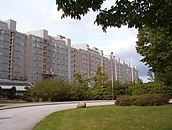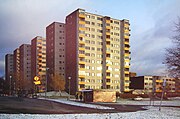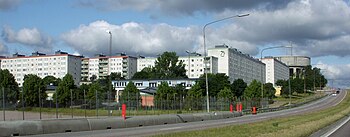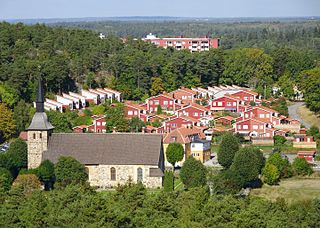
Botkyrka Municipality is a municipality in Stockholm County in east central Sweden, not far from the capital Stockholm. Its seat is located in the town of Tumba.
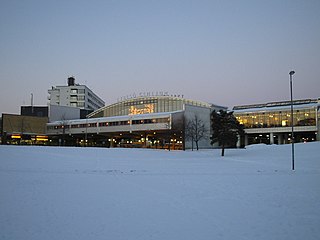
Tyresö Municipality is a municipality in Stockholm County in east central Sweden on the coast of the Baltic Sea.
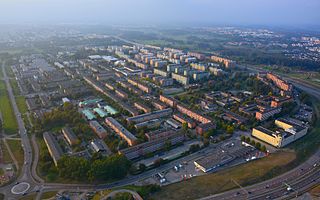
Rinkeby is a district in the Rinkeby-Kista borough, Stockholm, Sweden. Rinkeby had 19,349 inhabitants in 2016. The neighbourhood was part of the Million Programme.
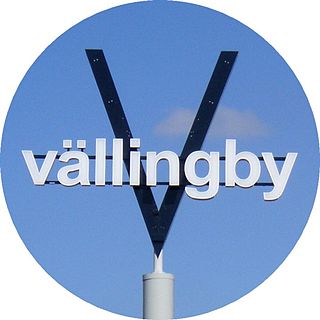
Vällingby is a suburban district in Västerort in the western part of Stockholm Municipality, Sweden.
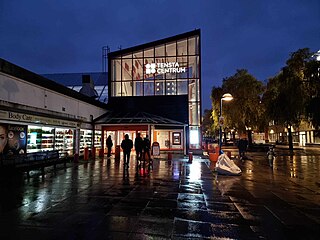
Tensta is a district in Spånga-Tensta borough, Stockholm, Sweden. There are about 6,000 apartments in Tensta and a population of 18,637 as of December 31, 2022.

Bergsjön is a district in eastern Gothenburg, Sweden. On January 1, 2011, Bergsjön and Kortedala became the Eastern District of Gothenburg as part of a larger reorganization of the city of Gothenburg; the number of district councils was halved, to ten. Bergsjön, as part of Eastern District of Gothenburg, is divided into two smaller areas: Western and Eastern Bergsjön. In Eastern Bergsjön construction and development in the area began in 1965, and in Western Bergsjön development started in 1967.
Social welfare in Sweden is made up of several organizations and systems dealing with welfare. It is mostly funded by taxes, and executed by the public sector on all levels of government as well as private organizations. It can be separated into three parts falling under three different ministries. Social welfare is the responsibility of the Ministry of Health and Social Affairs. Education is the responsibility of the Ministry of Education and Research. The labour market is the responsibility of the Ministry of Employment.

Skarpnäcksfältet is a subdistrict of Skarpnäcks Gård in the Skarpnäck borough of Stockholm, Sweden. Skarpnäcksfältet was built in the 1980s, and has 8,734 inhabitants as of December 31, 2009.

Fittja is a part of Botkyrka Municipality and the name of the Stockholm metro station in the area. It was settled during the 1970s and consists mostly of rental apartments. As of 2008, there were 7,458 people living in Fittja; 64.7% of them were of non-Swedish origin, of whom 25.1% were non-Swedish citizens.

Jordbro is a suburban locality situated in Haninge Municipality, Stockholm County, Sweden with 10,291 inhabitants in 2010.

Tynnered is one of 21 boroughs in the city of Gothenburg, Sweden. It is located in the western part of the city, about 8-10 kilometres from the inner city, and it has a population of 27,787 (2010) on 29.85 square kilometres (11.53 mi2). Alike several other boroughs of the city, Tynnered has a fairly high percentage of immigrants. On January 1, 2011, Tynnered became part of the district (stadsdelsnämnd) Western Gothenburg. In 2021 the stadsdelsnämd districts were replaced by larger stadsområde districts and Tynnered became part of South-West Gothenburg.
Norsborg is a part of Botkyrka Municipality in Stockholm County, Sweden. Norsborg consists of the residential areas Hallunda, Eriksberg and Slagsta. Norsborg and Hallunda are contiguous suburbs.
Biskopsgården is a district (stadsdelsnämndsområde) in Gothenburg Municipality, in western Sweden.

Husby is a district in Rinkeby-Kista borough, Stockholm, Sweden. Husby has 11,551 inhabitants as of December 31, 2007.

Lindängen is a neighbourhood in Söder in Malmö, Sweden. It has 6,874 inhabitants. In its 2017 report, Police in Sweden placed the district in the most severe category of urban areas with high crime rates.
Municipalities in Sweden are in some rare cases divided into smaller districts or urban districts, and are sometimes assigned administrative boards responsible for certain areas of governance in their respective areas. These districts are not specified by national Swedish law, but rather are created by individual municipalities, and thus the Swedish names of these districts vary greatly from municipality to municipality, including kommundelar, stadsdelar, stadsdelområden, primärområden, or stadsdelsnämndsområden. The degree of administrative autonomy of these districts similarly varies greatly, but is normally very limited.
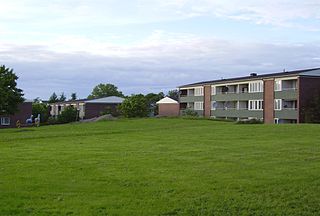
Skäggetorp is a city district in Linköping, Sweden, located northwest of downtown. The buildings are mostly two-story and three-story buildings, both condominiums and apartment buildings, which are built around a large center with office buildings, shops, bank, pharmacy and other services. In the area there are medical and dental offices, schools, child care, nursing home, church, playing fields and Ullevi allotment area.

Gottsunda, is a district in Uppsala, Sweden. In 2007, it had 9,474 inhabitants. The majority of the buildings are high-rise buildings built as part of the Million Programme in the 1960s and 1970s.

Storvreten is a residential area in Tumba, Sweden. Storvreten was built during the late 1960s and early 1970s.
Vulnerable area is a term applied by the Swedish Police Authority to areas with high crime rates and social exclusion. They are colloquially known as no-go zones. In the December 2015 report, there were 53 vulnerable areas, which increased to 61 in June 2017. The increase is reported to be due to better reporting, not a changing situation. The overall trend is that these areas are improving.




